Welcome to the delightful world of Japandi design, where the minimalist elegance of Japanese aesthetics meets the cozy functionality of Scandinavian style. Whether you’re a novice just dipping your toes into the waters of interior design or a seasoned decorator looking to infuse new life into your space, our guide, “Top 12 Japandi Interior Design Concepts,” is your perfect companion.
In this carefully curated list, you’ll discover a wealth of ideas that bridge the gap between simplicity and warmth, creating a harmonious environment that soothes the senses. These concepts are not just visually appealing; they offer practical benefits, such as maximizing space and enhancing tranquility, making them invaluable for any home.
Transforming your home with Japandi style offers the joy of creating a sanctuary that is both serene and stylish. With our guidance, you’ll feel empowered to seamlessly blend functionality with beauty, ensuring your living spaces are not only aesthetically pleasing but also a true reflection of your personal taste.
Natural Wood Accents (Warmth and Simplicity)
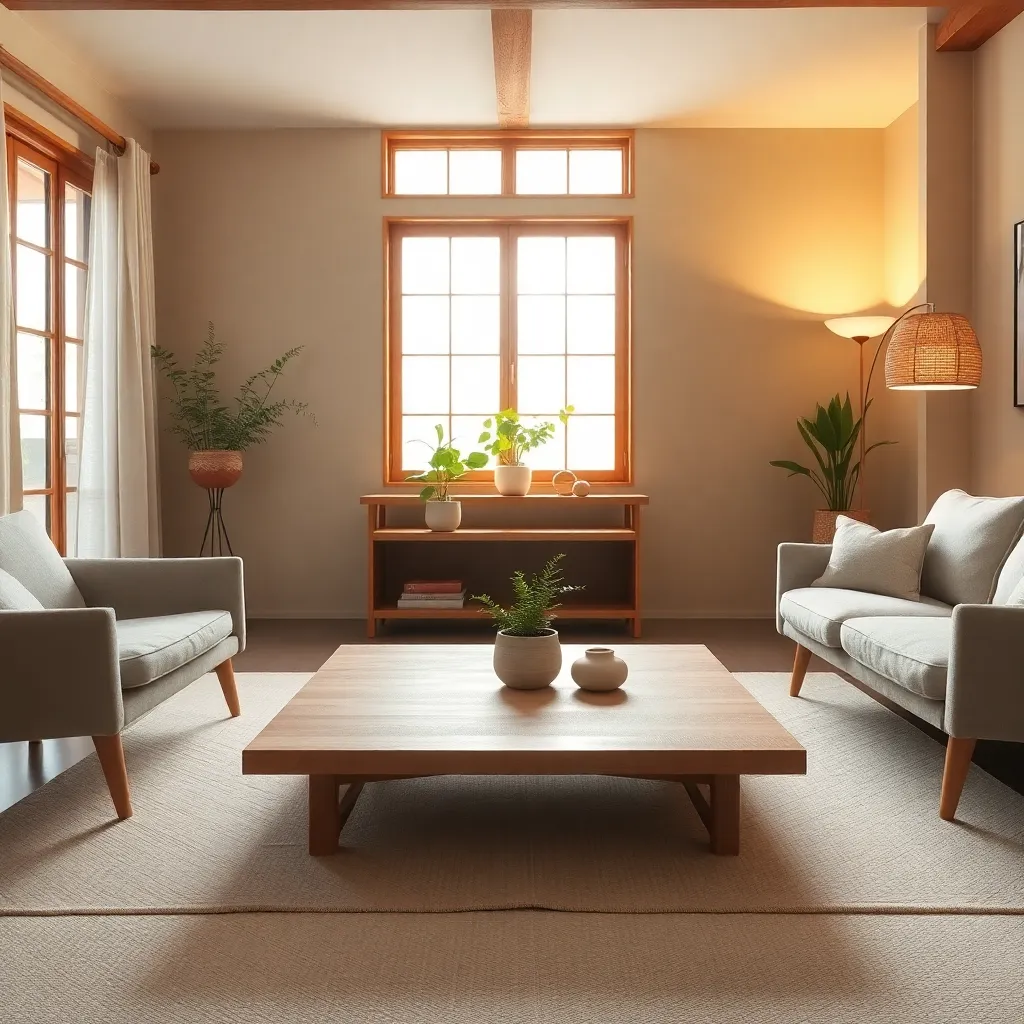
Natural wood accents are a hallmark of the Japandi style, effortlessly bringing warmth and simplicity into any space. To achieve this look, consider incorporating furniture made from oak, walnut, or birch, as these woods offer diverse tones that complement both Scandinavian and Japanese aesthetics.
When selecting furniture, opt for pieces with clean lines and minimal ornamentation to maintain a calm and cohesive atmosphere. A sleek wooden coffee table or a simple wooden bed frame can be perfect focal points, grounding your décor in understated elegance.
Incorporating wood into smaller elements like shelving or picture frames can also enhance the room’s warmth without overwhelming it. To add dimension, mix different wood tones, but keep them within a similar color family to preserve the design’s harmony.
For advanced decorators, consider using natural wood accents in unexpected places, such as a wooden backsplash in the kitchen or a wood-paneled accent wall. These elements can create subtle yet impactful statements, making the home feel more inviting and connected to nature.
Minimalist Furniture Selection (Clutter-Free Serenity)
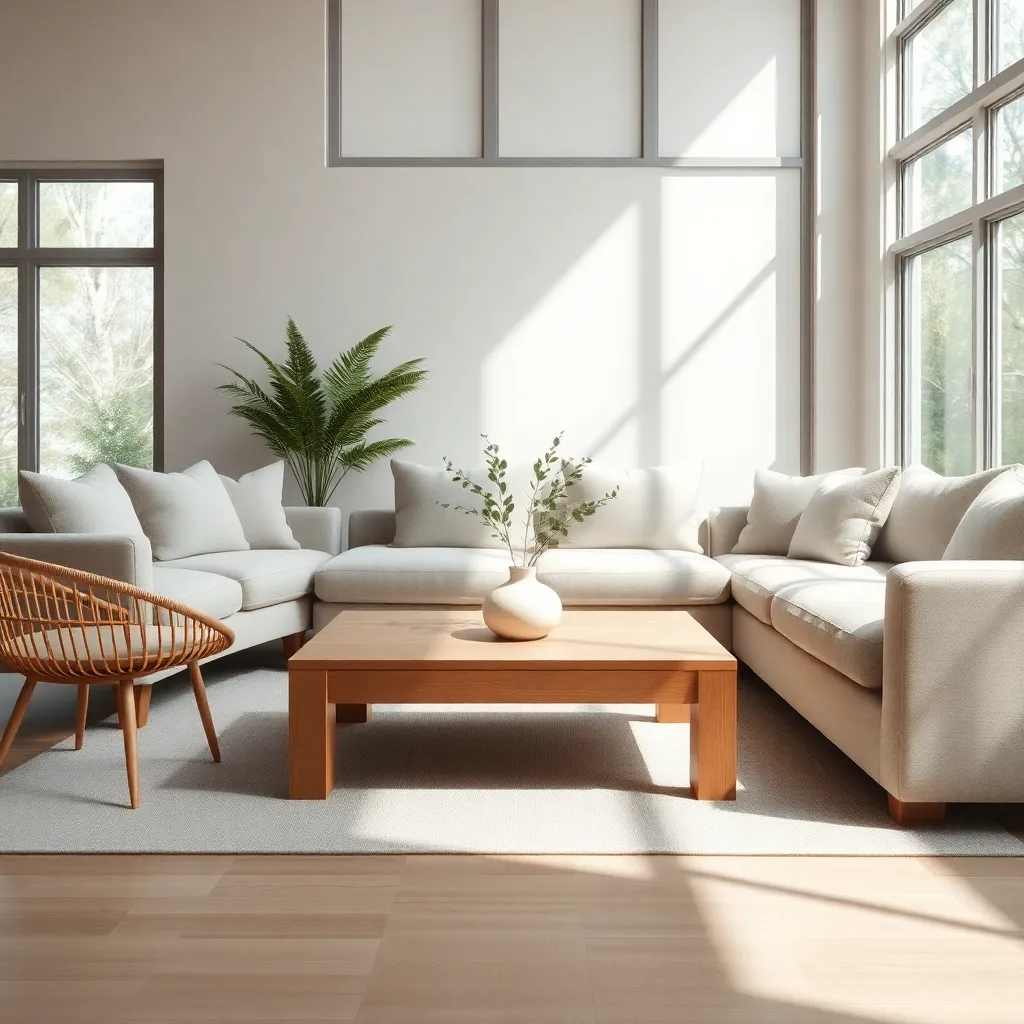
Choosing minimalist furniture is a fundamental step in achieving Japandi’s clutter-free serenity. Focus on pieces that combine function and form, such as a low-profile sofa with clean lines and neutral upholstery. For beginners, starting with a few essential items like a sleek coffee table or a streamlined armchair can significantly impact the room’s atmosphere. Look for furniture made from natural materials like wood or linen to maintain the warm simplicity characteristic of Japandi design.
Incorporating multi-functional furniture helps maximize space while maintaining a minimalist aesthetic. Consider investing in a dining table with extendable features or a bed with built-in storage to keep the area tidy. For color schemes, stick to a palette of soft earth tones and muted hues that evoke a sense of calm and balance. Advanced decorators can experiment with subtle contrasts by adding a few darker accent pieces to create depth without overwhelming the space.
Placement is key when arranging minimalist furniture; ensure each piece has room to breathe. Avoid crowding furniture together, and instead, allow for open pathways that encourage flow and movement. Think about the room’s natural light and position seating to take advantage of it, enhancing the serene ambiance. To elevate the design, add a few curated decorative items, such as a simple ceramic vase or a textured throw, to introduce texture and personality without clutter.
Neutral Color Palette (Harmonious Backdrop)
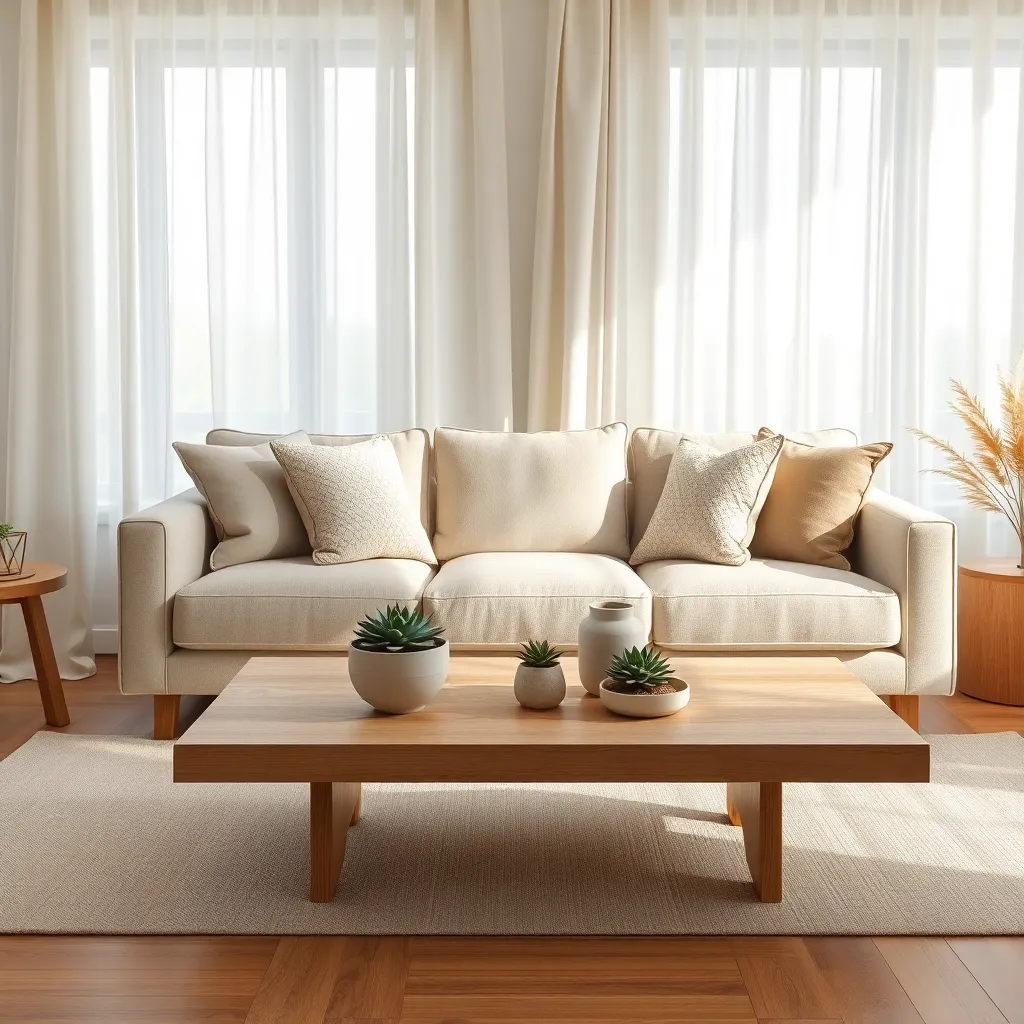
Incorporating a neutral color palette into your Japandi design creates a harmonious backdrop that emphasizes simplicity and calm. Opt for shades like soft whites, muted greys, and gentle beiges to establish a serene atmosphere that complements both the Japanese and Scandinavian design principles.
To enhance this tranquil setting, consider using natural materials such as linen, cotton, and wool in your textiles. Layer these textures to add depth and interest without overpowering the subtle color scheme, creating a visually pleasing yet understated decor.
When selecting furniture, choose pieces in light woods or painted in neutral tones to maintain continuity throughout the space. Position these items strategically to allow for a spacious feel, utilizing negative space as a design element to enhance the minimalist aesthetic.
For advanced decorators, integrate subtle accents in soft pastel colors or metallics like brushed brass and matte black to introduce sophistication without disrupting the palette. These elements can be incorporated through accessories such as vases, lamps, or frames, adding a personalized touch to your Japandi-inspired home.
Textured Rugs (Soft Underfoot Comfort)
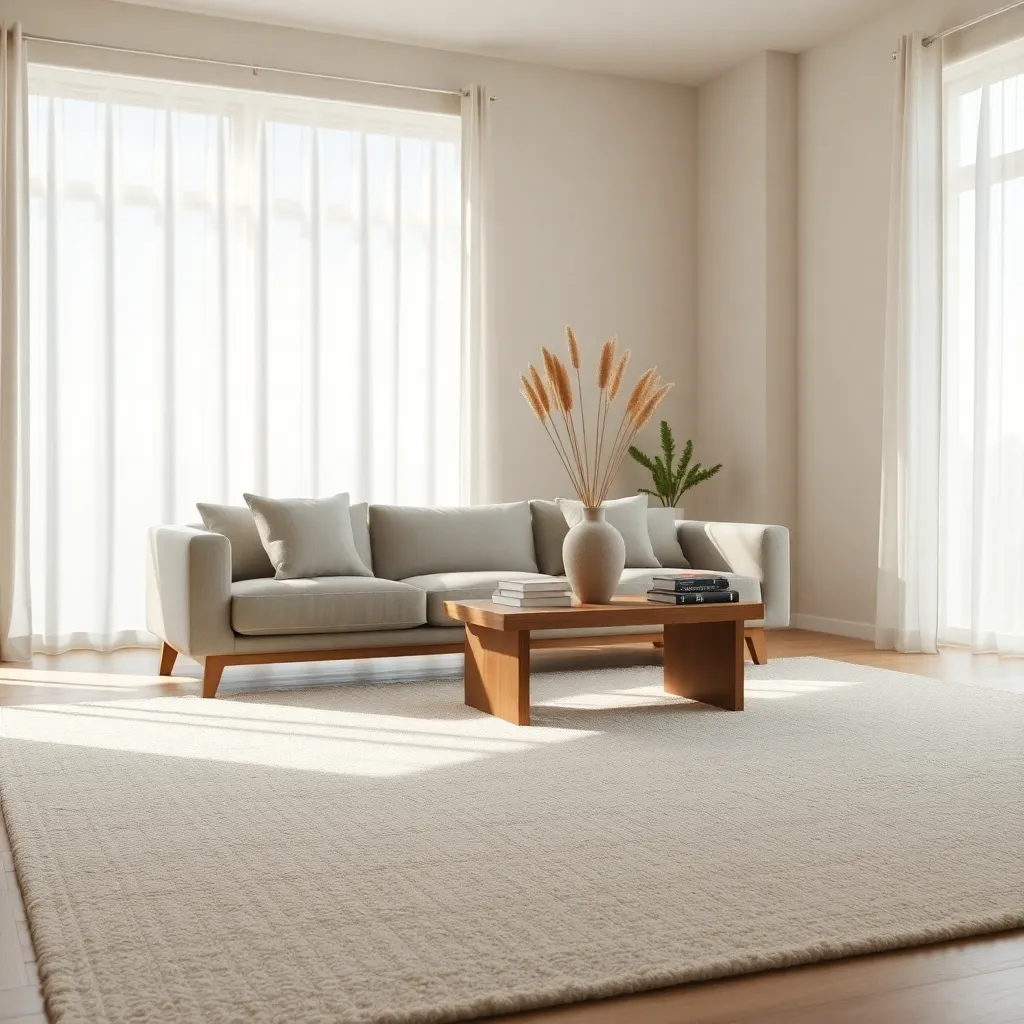
Incorporating textured rugs into a Japandi interior can greatly enhance the tactile experience of your home. Opt for rugs made from natural fibers like wool or jute, which provide both softness underfoot and visual interest through their rich textures.
To maintain the Japandi style’s minimalist aesthetic, select rugs in neutral colors that complement your existing color palette. Consider shades like cream, soft gray, or muted earth tones, which will harmonize with the serene and balanced environment typical of Japandi designs.
Placement is key when introducing textured rugs into your space. Position them strategically to define areas, such as under a coffee table in the living room or beneath a dining set, ensuring they anchor the furniture and create a cohesive look.
For those looking to add a layer of sophistication, consider layering rugs of varying textures. This advanced technique involves placing a smaller, intricately textured rug over a larger, simpler one, enhancing the depth and dimension of your floor space while maintaining a calm and cohesive appearance.
Functional Storage Solutions (Streamlined Organization)
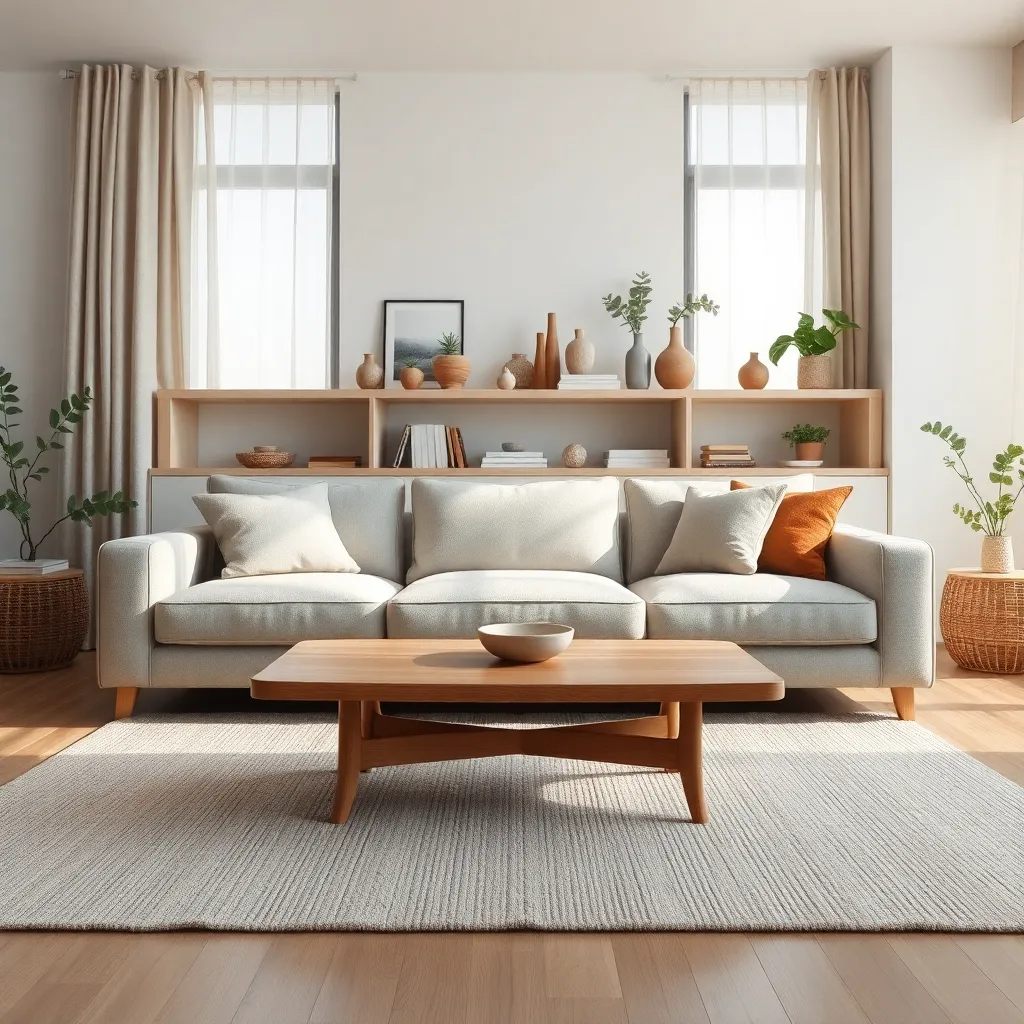
Functional storage is a cornerstone of Japandi design, blending minimalism with practical use. Consider **multi-functional furniture** like a bench with hidden storage or a coffee table with shelves to keep your space tidy and stylish.
To maximize space efficiency, incorporate **built-in storage solutions** that seamlessly integrate with your home’s architecture. For instance, wall-mounted shelves or recessed cabinets can offer ample storage while maintaining a clean, uncluttered aesthetic.
Embrace natural materials to stay true to the Japandi style, using **bamboo or light wood** for a cohesive look. These materials not only provide durability but also add a warm, organic feel to your storage pieces, enhancing the calming atmosphere of your home.
For a sophisticated touch, opt for storage units in **neutral tones** like soft whites, muted grays, or earthy browns that complement the Japandi palette. This color scheme ensures your storage solutions blend seamlessly with other design elements, creating a harmonious and inviting environment.
Indoor Greenery (Nature-Infused Calmness)
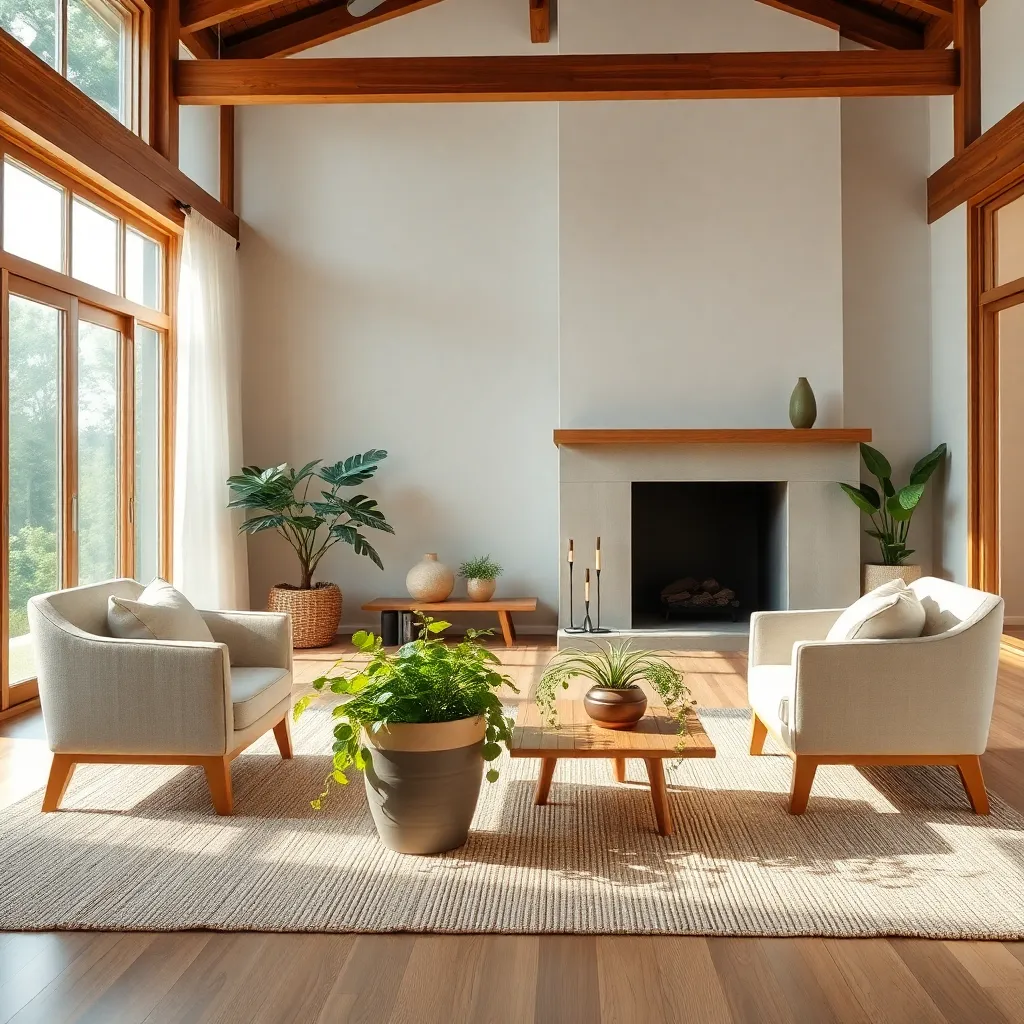
Incorporating indoor greenery into your Japandi design can elevate your home with a touch of nature-infused calmness. Choose plants like fiddle leaf figs or snake plants that thrive in indoor environments and complement the minimalist aesthetic.
For beginners, start with easy-to-care-for plants such as pothos or peace lilies, which are forgiving and adaptable. Place these plants on sleek wooden shelves or in ceramic pots that match your overall color palette to maintain a cohesive look.
Consider using large planters in neutral tones to anchor more significant spaces, creating a seamless transition between the indoors and outdoors. Advanced decorators might experiment with vertical gardens or hanging planters to add dimension without sacrificing floor space.
Strategically place plants near natural light sources to ensure they thrive while also enhancing the room’s ambiance. Incorporating greenery not only purifies the air but also introduces serenity and balance to your Japandi home.
Layered Lighting (Adaptive Ambiance)
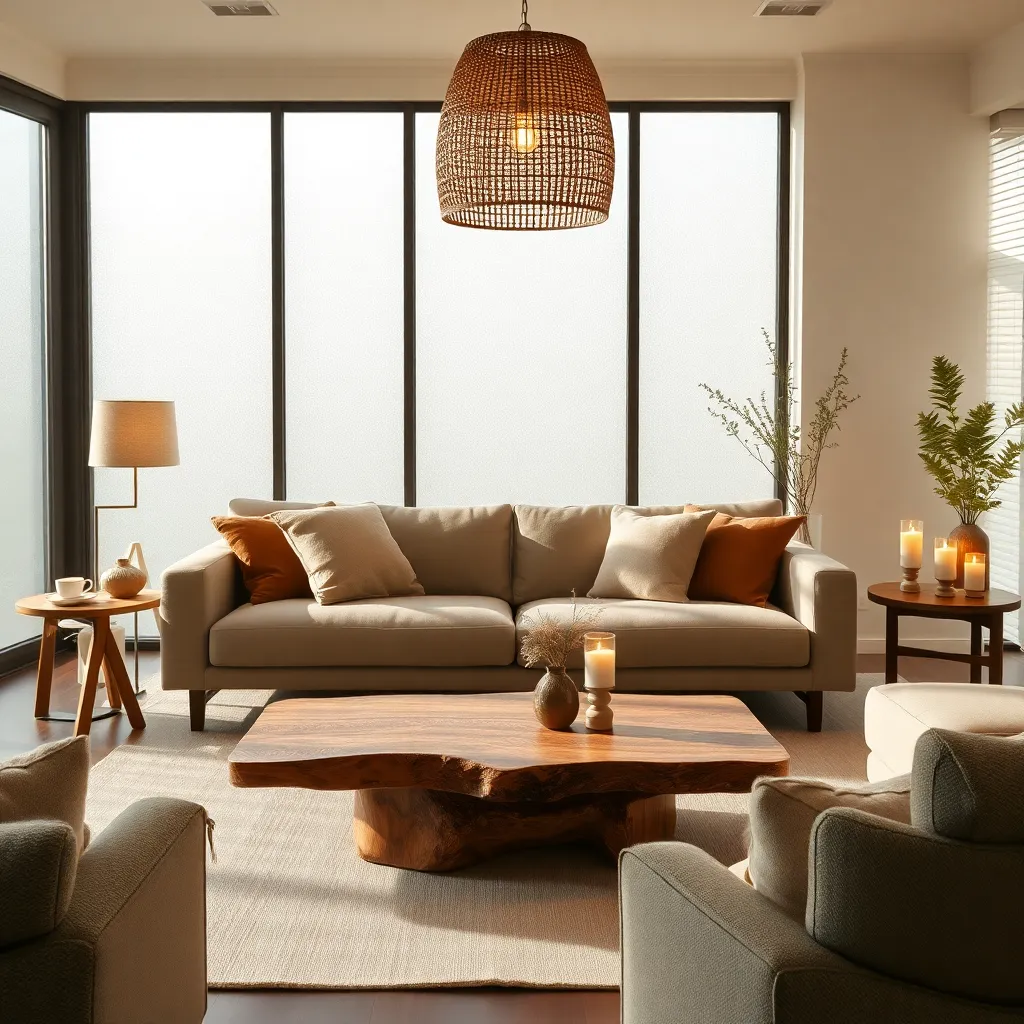
Layered lighting can significantly enhance the Japandi aesthetic by creating an adaptive ambiance that suits various moods and activities. Start by incorporating a mix of lighting types, such as ambient, task, and accent lighting, to ensure each layer serves a distinct purpose and enhances the room’s functionality.
For ambient lighting, consider using pendant lights with simple, clean lines that align with the Japandi style’s minimalist sensibilities. Choose fixtures in natural materials like wood or paper, which harmonize with the neutral, earthy color palette common in Japandi interiors.
Task lighting is essential for areas where specific activities occur, such as reading or cooking. Place adjustable floor lamps or wall-mounted lights near reading nooks or above kitchen counters, selecting designs that combine Japanese elegance with Scandinavian simplicity, like those with bamboo or matte metal finishes.
Accent lighting can highlight architectural features or focal points, adding depth and warmth to the space. Use LED strip lights under shelves or cabinetry to draw attention to beautifully curated displays, or position small spotlights to illuminate textured walls or artwork, fostering an inviting atmosphere.
Wabi-Sabi Decor Pieces (Embracing Imperfection)
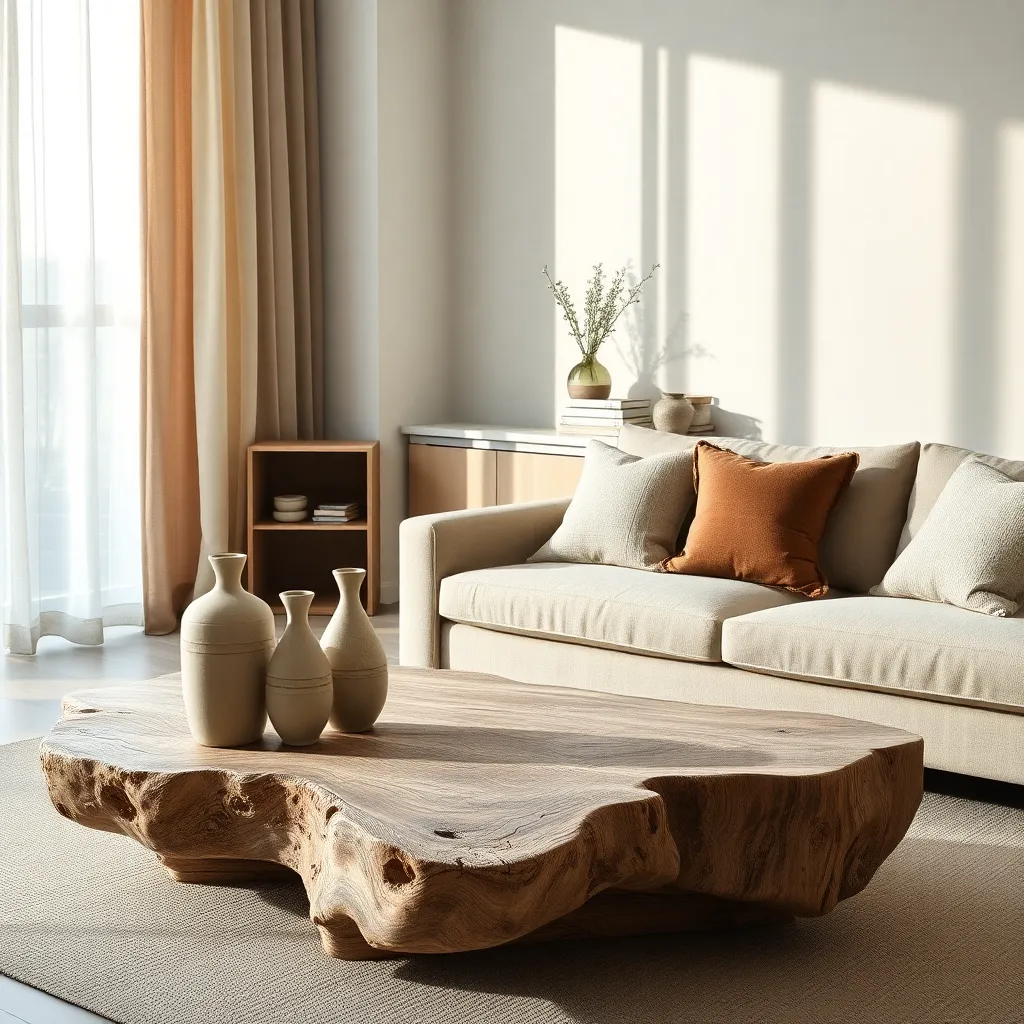
Wabi-Sabi decor invites you to embrace the beauty of imperfection, creating a serene and authentic atmosphere in your home. Start by choosing furniture pieces with natural materials like wood, stone, and clay, which add a sense of warmth and earthiness to your space.
Incorporate items with irregular shapes or uneven surfaces to emphasize the Wabi-Sabi aesthetic. For example, a handmade ceramic vase or a wooden coffee table with a live edge can serve as captivating focal points that celebrate the charm of the imperfect.
Color schemes in Wabi-Sabi design focus on muted tones that reflect the natural world. Opt for shades such as soft grays, earthy browns, and muted greens to create a calming backdrop that allows your decor pieces to stand out.
Advanced decorators might consider layering textures to enhance the Wabi-Sabi feel. Use a mix of materials like woven fabrics and rough-hewn wood to add depth and dimension, ensuring each piece feels connected yet distinct.
Zen-Inspired Artworks (Mindful Visual Focus)

Drawing inspiration from Zen philosophy, artworks that embody mindfulness can transform a space into a serene retreat. To achieve this, select pieces that feature calming colors such as soft whites, gentle greens, and muted blues, which evoke tranquility and balance.
Consider incorporating artwork that represents natural elements like flowing water or gentle landscapes to create a connection with nature. Opt for simple, minimalist frames to keep the focus on the artwork itself, allowing the piece to breathe life into your room without overwhelming the senses.
Placement is key when using Zen-inspired art to enhance a mindful environment. Display these artworks at eye level in locations where you often pause, such as near a meditation corner or above a reading nook, to invite moments of reflection and calm.
For those looking to deepen this aesthetic, experiment with traditional Japanese art forms such as sumi-e, which uses ink wash painting techniques to convey harmony and simplicity. These artworks can serve as focal points in a room, drawing attention while subtly reinforcing the Japandi theme’s emphasis on peaceful living.
Open Floor Plans (Fluid Space Utilization)
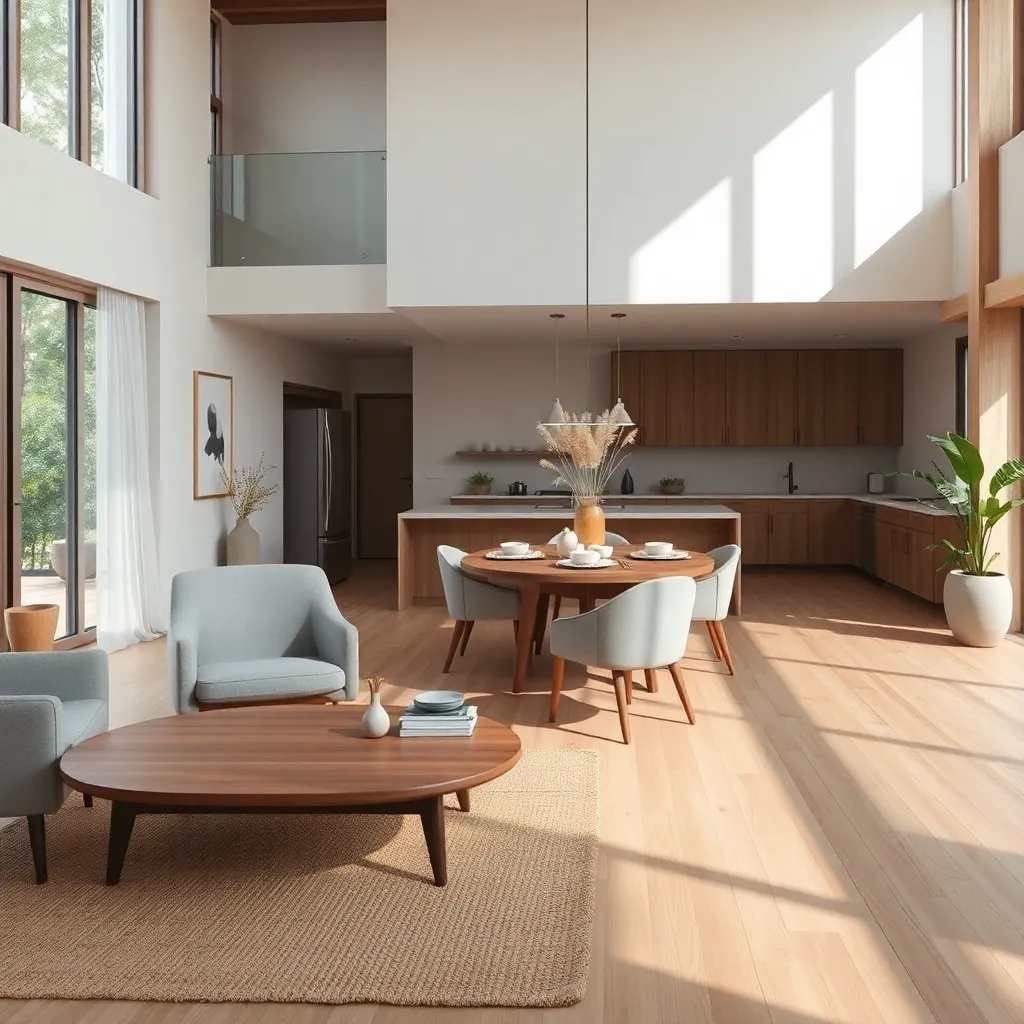
Open floor plans offer a seamless transition between different functional areas, enhancing the sense of spaciousness and flexibility in a home. To achieve the perfect Japandi aesthetic in an open floor plan, consider using neutral color palettes like soft whites, muted grays, and earthy tones to create a cohesive and calming environment.
Furniture selection is crucial in defining spaces without the need for walls. Opt for multi-functional pieces such as a low-profile sofa that can serve as a subtle boundary between living and dining areas, while maintaining visual harmony.
Incorporating natural materials like wood and stone can add warmth and texture to the open space. Choose pieces with simple, clean lines to maintain the minimalist elegance that Japandi is celebrated for, ensuring the space feels uncluttered and serene.
For a more advanced approach, use area rugs to delineate different zones while adding a layer of comfort and style. Consider rugs in natural fibers like jute or wool, which not only enhance the aesthetic but also contribute to the tactile experience of the space.
Tatami Mats and Futons (Traditional Comfort)
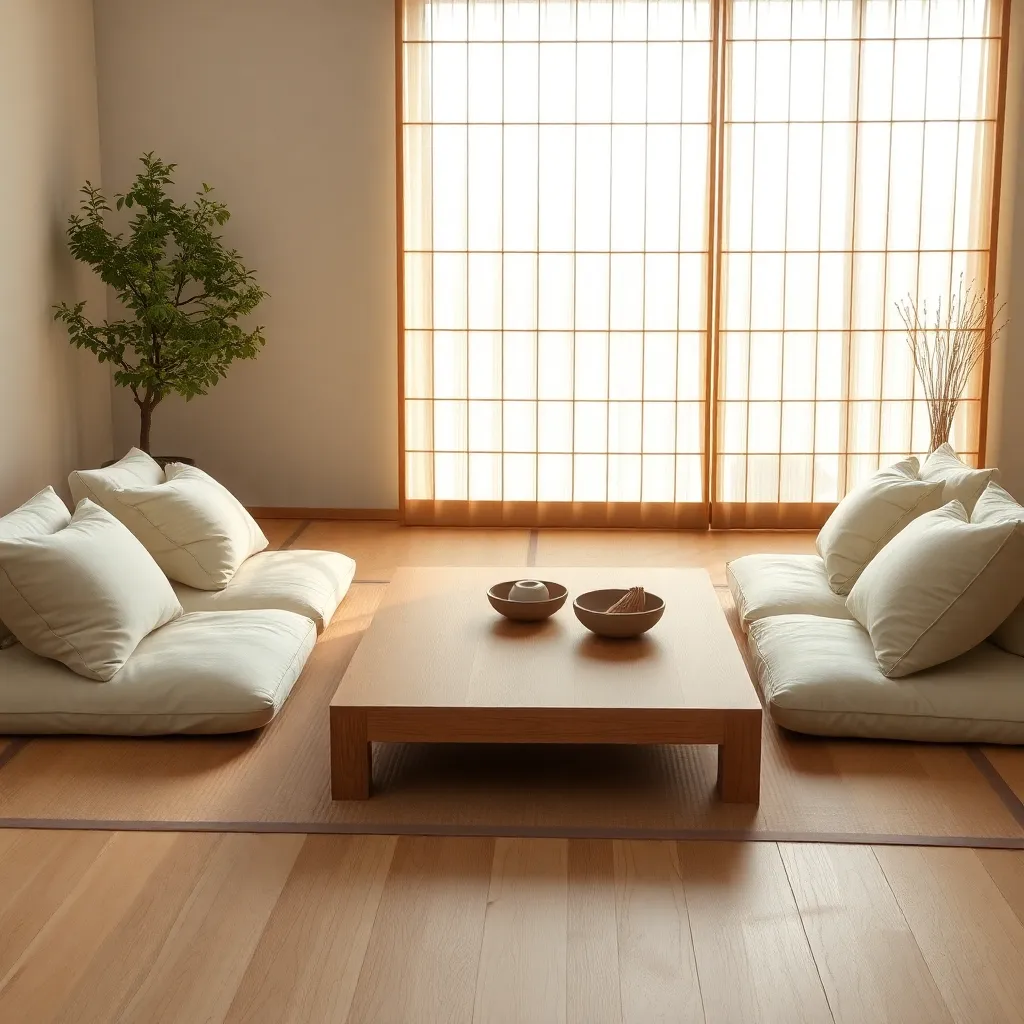
Incorporating tatami mats and futons into your home can transform any space into a serene retreat. Tatami mats, traditionally made from rice straw and woven rush grass, offer a natural and earthy touch that aligns with the Japandi aesthetic. For an authentic look, consider using tatami mats to cover the entire floor of a room or as a simple area rug to define a space. Ensure the colors are neutral or earth-toned to maintain a harmonious balance with wooden furniture and other natural elements.
When selecting a futon, opt for a design that is both comfortable and minimalist, emphasizing clean lines and functionality. Futons with removable covers in neutral shades such as beige, sage, or soft gray can provide a versatile foundation for your space. Arrange the futon in a way that allows easy access and movement around the room, ideally near a window to take advantage of natural light. To add a touch of texture, layer with a few cushions or a knitted throw in complementary colors.
For those looking to blend traditional elements with modern design, consider integrating modular tatami mats that can be rearranged according to the occasion. These mats can serve as flexible seating or even a low table surface, enhancing the functionality of your living space. Pair these with low-profile furniture to maintain a sense of openness and flow consistent with Japandi design principles. Advanced decorators might explore custom-sized tatami mats to precisely fit unique room dimensions, creating a seamless look.
Finally, remember that the placement of these elements is crucial to achieving the desired aesthetic and comfort. Tatami mats should align with the room’s layout, guiding the flow of movement and enhancing the visual appeal. Placing a futon against a backdrop of a simple, textured wall can create a striking focal point that draws the eye while maintaining a calming atmosphere. By thoughtfully integrating tatami mats and futons, you can create a space that is both traditionally comforting and elegantly modern.
Organic Materials Integration (Eco-Friendly Choices)
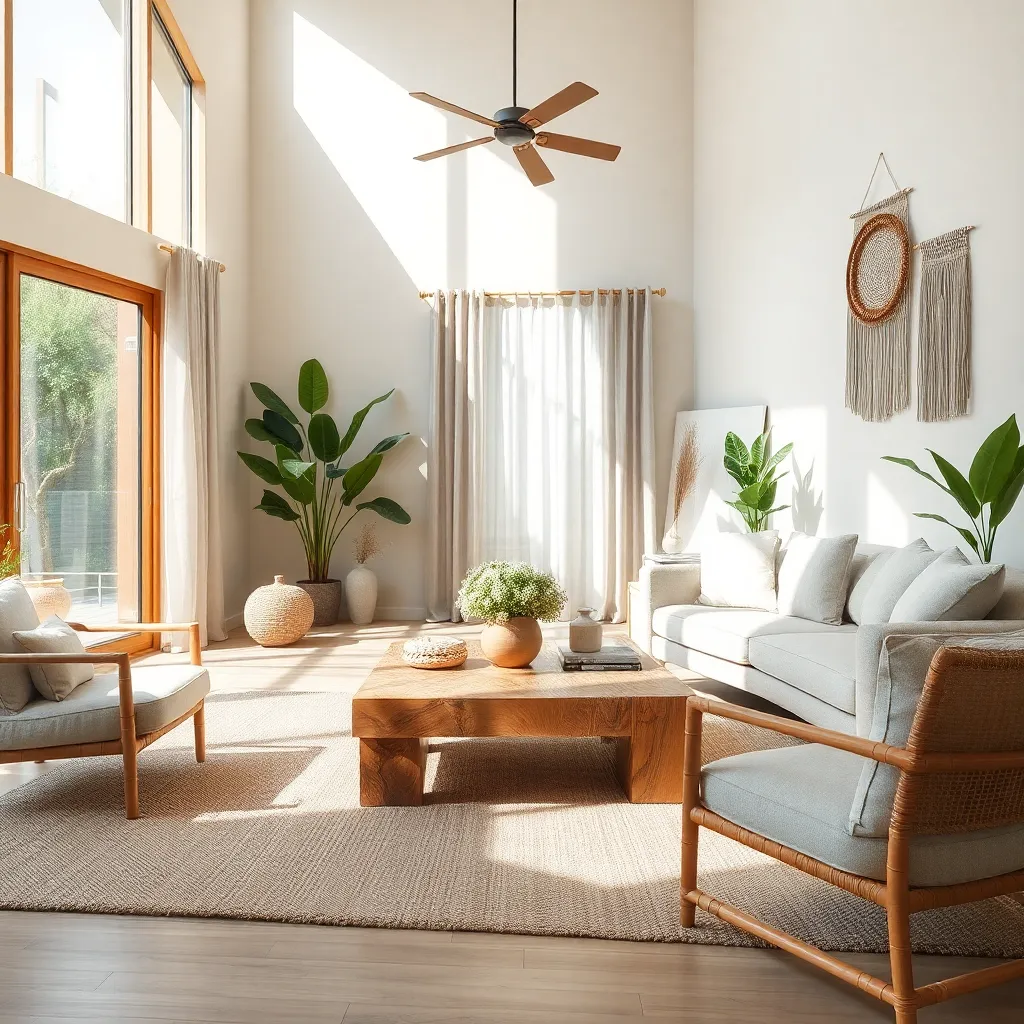
Incorporating organic materials into your Japandi design can create a serene and eco-friendly atmosphere. Consider using natural materials such as bamboo, jute, and reclaimed wood to add texture and warmth to your space.
Furniture made from sustainable sources, like a bamboo coffee table, not only looks beautiful but also reduces environmental impact. Place a jute rug beneath your seating area to enhance the cozy ambiance while maintaining a minimalist aesthetic.
For those looking to add more greenery, integrating plants like ferns or succulents in ceramic pots can enhance the natural feel of your room. Position these plants near natural light sources to ensure they thrive, and choose pots in neutral colors to maintain the space’s calm and simple look.
For a more advanced touch, consider using organic fabrics for your window treatments and upholstery. Linen or cotton curtains can soften the look of your windows and complement the overall Japandi theme by allowing natural light to filter through gently.
Conclusion: Growing Success with These Plants
In exploring the harmonious blend of Japanese minimalism and Scandinavian functionality, the ‘Top 12 Japandi Interior Design Concepts’ article offers insightful parallels to nurturing fulfilling relationships. We delved into creating balance, embracing simplicity, cultivating warmth, celebrating natural elements, and focusing on quality over quantity—each echoing essential relationship principles. The importance of intentional space, adaptability, and fostering comfort highlights the need for flexibility and support in partnerships. By understanding these concepts, you can enhance both your living space and interpersonal connections.
As an actionable next step, choose one concept to discuss with your partner or loved ones, fostering a dialogue that strengthens your bond. Whether it’s embracing simplicity or prioritizing quality time, let this conversation be a stepping stone towards deeper understanding and connection.
Don’t forget to save or bookmark this article, ensuring these valuable insights are always at your fingertips. By integrating these Japandi-inspired principles into your relationships, you pave the way for enduring happiness and growth. As you continue on this journey, remember that the art of balancing simplicity and warmth is a timeless recipe for relationship success.
